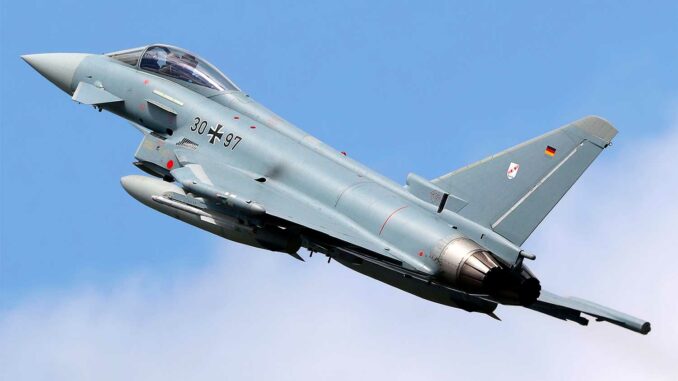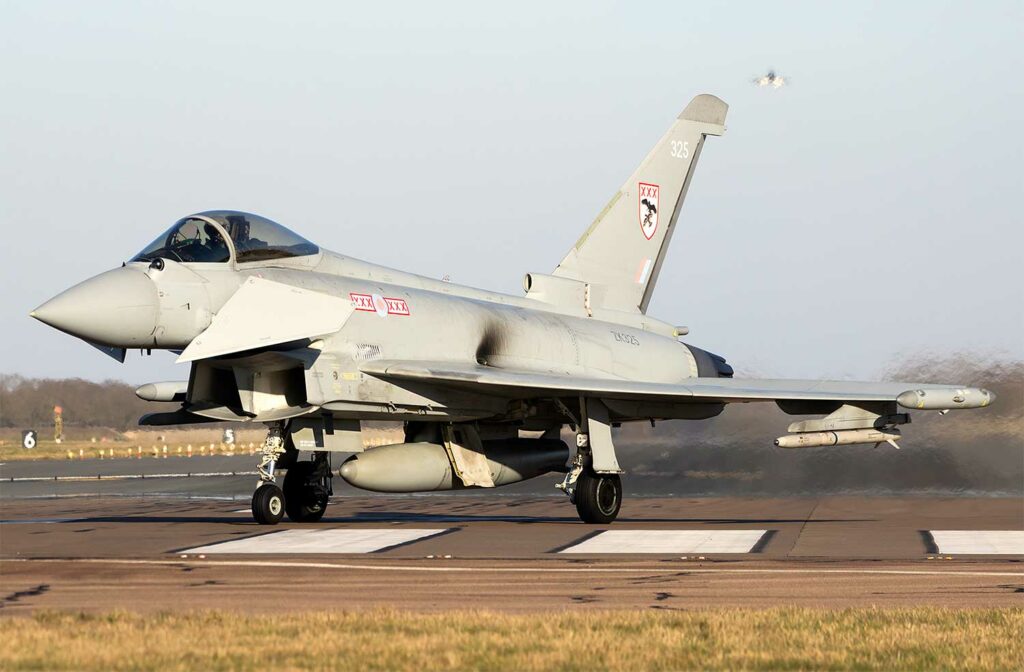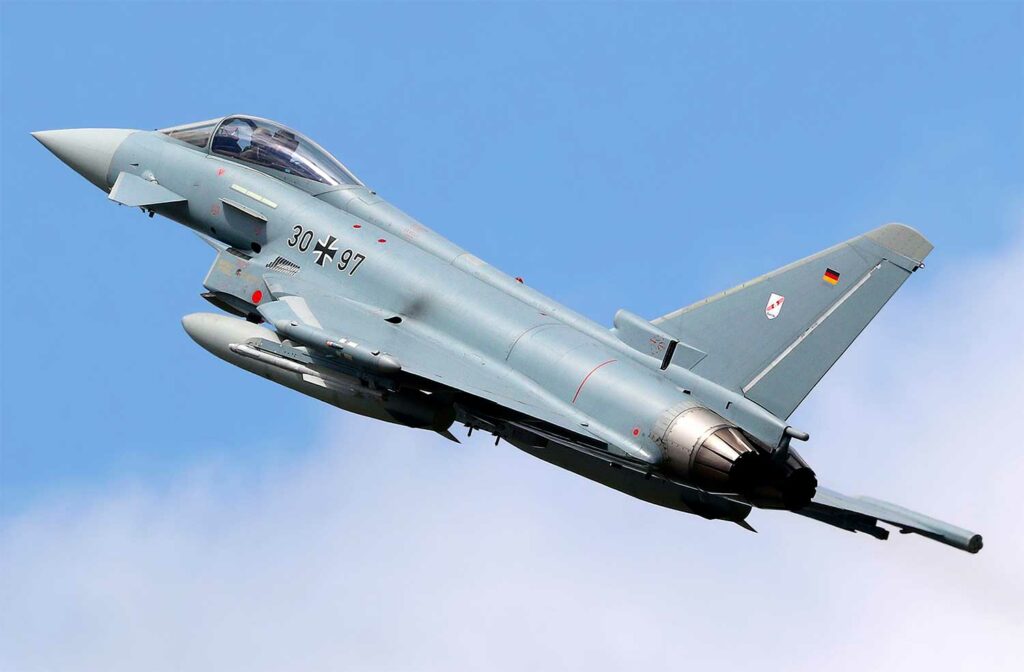
An agreement between Ankara and London could make the Typhoon Turkey’s main fighter jet as its F-16s wear out.
The Eurofighter Typhoon is set to become Turkey’s new fighter jet, following a memorandum of understanding signed on July 23, 2025, between the United Kingdom and Turkey. This strategic development comes after Ankara’s exclusion from the F-35 program in 2019 and the gradual obsolescence of its F-16 fleet. The contract, which is still to be finalized, could involve 40 Tranche 4 aircraft, accompanied by latest-generation Meteor missiles. The agreement also involves Turkish industrial participation. This order would be vital for BAE Systems, which is threatened by the closure of the Typhoon assembly line in Warton. With the national TF Kaan program not due to be completed before 2030, the Typhoon represents a credible transitional solution to guarantee Turkish air defense and maintain strategic balance with Greece.

A strategic shift for Ankara after being excluded from the F-35 program
The potential purchase of the Eurofighter Typhoon is part of a diplomatic and industrial process that began after Turkey was excluded from the F-35 program in 2019. This exclusion followed the purchase of Russian S-400 defense systems, which were deemed incompatible with NATO standards. Ankara had initially ordered 100 F-35As, with direct industrial participation in their production, notably via Turkish Aerospace Industries.
This forced withdrawal has severely disrupted the Turkish Air Force’s capability planning, which had envisaged the F-35 as its future main fighter to gradually replace its aging F-16s. The lack of visibility on a credible alternative has opened up a series of technical and diplomatic explorations: Russian offers of Su-57s have been rejected, difficult negotiations with Washington on new F-16s have taken place, followed by discussions with Europe.
At the same time, Ankara has attempted to revive its relations with the United States. In January 2024, diplomat Victoria Nuland mentioned a possible return to the F-35 program, provided that Turkey abandoned the S-400s. Despite this sign of openness, no agreement has been reached, especially as the US Congress continues to block any strategic rapprochement as long as regional tensions persist, particularly with Greece and over Syria.
The Typhoon solution, backed by a political agreement between London and Ankara, therefore represents a concrete shift towards a European reorientation of Turkish rearmament, while strengthening British industrial chains.
Typhoon Tranche 4: technical capabilities and uncertain timetable
The agreement signed at the IDEF 2025 exhibition remains at this stage a memorandum of understanding, but several elements indicate that negotiations are at an advanced stage. According to official statements, the Turkish order would be for 40 Typhoon Tranche 4 aircraft, the latest version of the European aircraft.
This version features modernized avionics, an AESA Captor-E electronically scanned radar, and advanced interoperability capabilities. It is also compatible with the long-range Meteor missile, capable of engaging targets at ranges of over 200 kilometers, a major strategic advantage in the context of tensions with Greece, which is already equipped with the Meteor via its Rafale aircraft.
The Typhoon Tranche 4 can reach Mach 2, with a service ceiling of 16,700 meters and a weapon payload of approximately 7,500 kg. It can operate in a wide range of missions: air superiority, air-to-ground strikes, reconnaissance, and interception.
However, neither the delivery date nor the training schedule for Turkish pilots has been specified. The final assembly process is shared between the four European partners in the program (the United Kingdom, Germany, Spain, and Italy). However, a significant portion of production could be located in Turkey, under the usual terms of industrial offset agreements.
This order would also be crucial to keeping the Warton assembly line in the UK in operation, which was scheduled to close permanently in the absence of new orders after the delivery of the aircraft to Qatar.
A political decision with bilateral economic and industrial implications
The purchase of the Typhoon goes beyond the operational dimension. It addresses major industrial challenges on both sides. For Turkey, it is a question of ensuring the transition from aging F-16s to the entry into service of the national TF Kaan program, scheduled for 2030 at the earliest. The Eurofighter is therefore a temporary but robust solution to maintain the air force’s capabilities.
For the United Kingdom, it is a matter of saving thousands of jobs in the military aerospace industry. The Warton assembly line employs around 5,000 people directly and more than 20,000 indirectly in subcontracting. The agreement, welcomed by the British Prime Minister, is also a tool for economic diplomacy: maintaining Typhoon exports will support the national defense industry, which has been in decline since European orders dried up.
The Unite trade union pointed out that the closure of Warton would have been a strategic and social failure for the country. Exports to Ankara, although controversial in some political circles, therefore constitute a lever for industrial balance.
From a commercial standpoint, this sale could represent a total amount of €7 to €10 billion, including all missiles, spare parts, maintenance, and training.

Enhanced cooperation, but still subject to political approval
The Eurofighter program is based on multinational governance. Any sale to a third country must be approved by all partners. However, Germany has long opposed this, particularly for geopolitical reasons: tensions in the eastern Mediterranean, Turkish military interventions in Syria, and Ankara’s position on Sweden’s accession to NATO.
Berlin’s green light, confirmed by Der Spiegel magazine, was obtained in July 2025 via its Federal Security Council. This diplomatic turning point shows that Germany has agreed to align itself with a more flexible approach, probably in exchange for guarantees on the use of the aircraft and supervision of certain technical aspects.
However, this green light does not mean that there will be no debate in the Bundestag. The Turkish issue remains sensitive, particularly with regard to human rights and power projection. Although likely, the contract may still be held up by internal political factors or budget revisions in Ankara.
The Typhoon in competition with the Kaan and Turkish drones
The acquisition of Typhoons comes at a time of diversification of Turkish defense programs. The TF Kaan project, developed by Turkish Aerospace Industries, made its maiden flight in February 2024. This fifth-generation aircraft, with a low radar signature design, is intended to symbolize Ankara’s industrial autonomy in combat aviation.
However, the program is suffering from major technical delays, particularly with regard to the engine. The first deliveries are not expected before 2030-2032. At the same time, Turkey is also developing a fleet of advanced attack drones, such as the ANKA-3 flying wing and the Bayraktar Kizilelma, which is halfway between a drone and a light fighter.
These autonomous systems represent an alternative for certain missions, but do not replace the Typhoon’s air-to-air combat capabilities in a symmetrical confrontation with other states.
The choice of the Typhoon is therefore a realistic compromise: acquiring a proven aircraft, in service in several NATO countries, to secure air capabilities until a credible national offering emerges.
War Wings Daily is an independant magazine.